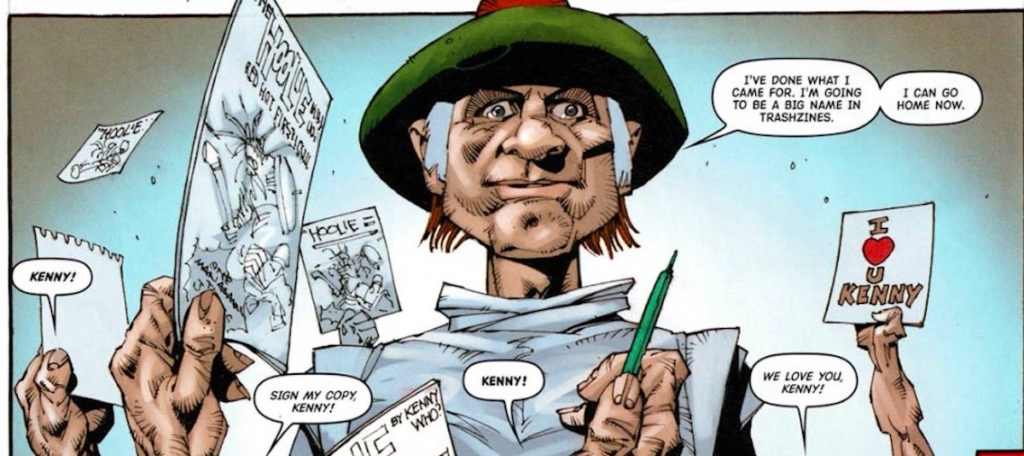There’s a man, an artist, looking at a work of art. In fact, it’s his work of art – the lines, the brush strokes, the style, are easily recognizable. But he didn’t make it. Shocked, Scottish comics Artist Kenny Who? (the question mark is part of the name) can only utter – “It’s me – my art – churned out by a machine!” Welcome to Mega City One, home for Judge Dredd, in which the foreign visitor is in for a rude awakening about the nature of art in the modern age.
“Kenny Who?” was created by Dredd’s co-creator John Wagner and fellow Scottish artist Cam Kennedy. The character appeared in three stories by this creative team, all of which lampoon – with the strip’s usual lack of subtlety – the comics industry (in both America and Britain) in a manner that felt timely then and feels even more timely now, for “now” appears to be the new age of art.
In 2022, still reeling from the odd obsession with NFTs, the world of visual art found something new to obsess over: AI Art. It’s not a new development – Harold Cohan’s AARON has been in development since 1972 – but only recently did AI Art programs become publicly available and popular to use. For a brief flash in late 2022 you couldn’t open a social network without seeing hundreds or thousands of images created via DALL-E or Stable Diffusion. The text-to-speech model allowed people to input prompts, containing everything from the desired subject to a particular style (either an artist or a movement) and see what happens.
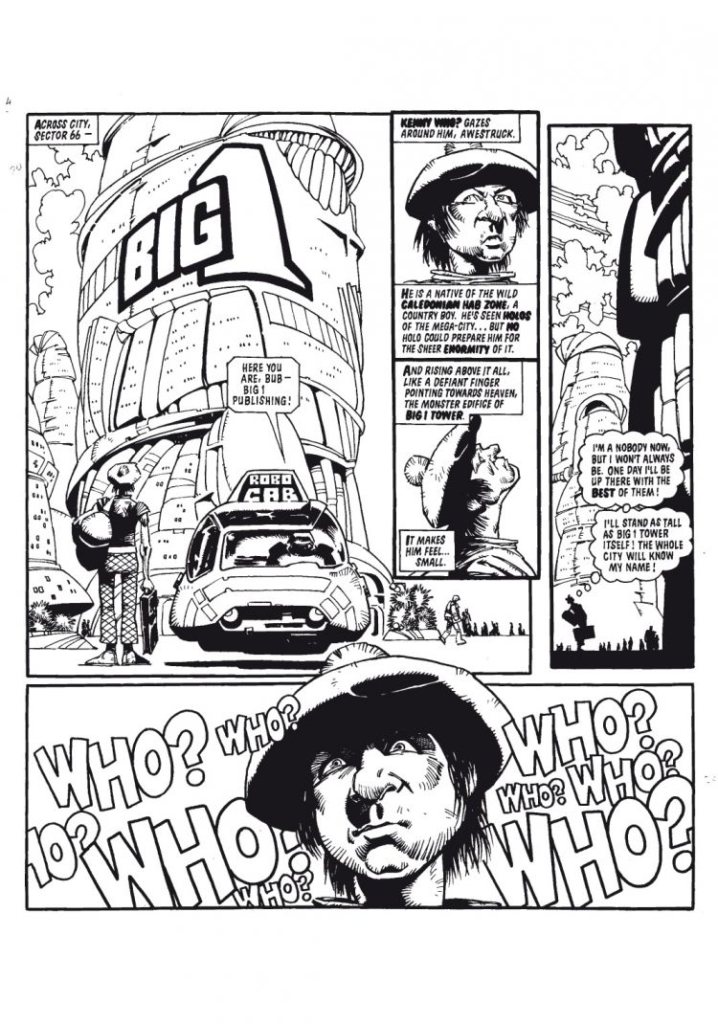
What happened, unsurprisingly enough, was that people discovered a new way not to pay artists. In a speed unheard of outside the realm of theoretical physics a whole generation of self-proclaimed “AI Artists” came into being; many of which were quite happy to proclaim how good it is to be free from the need to pay a living person for their service.
“Art is dead, dude,” said a man who just won an art competition by entering a few sentences into an automatic generator – and he does not seem to say it with much sadness either.
Pretty soon there followed a magazine with an AI cover (with a subheading boasting that it took “only 20 seconds to make”). It’s too early to say if things are going to be truly different from now on, or is this just another crush-and-burn case like NFTs. But at the moment, Wagner and Kennedy’s science fiction fever dream now appears to be a rather horrific reality. Of course, we shouldn’t be too surprised: like much of Judge Dredd’s storied history, the creators weren’t blessed with the gift of prophecy from Apollo…but were simply looking at the world as is, and saw where it was going.
The first of the ‘Kenny Who? Trilogy’ is called simply The Art of Kenny Who? In it, Kenny Who? arrives from Calhab (Scotland) to Mega City One (America) hoping to find a job at the local comics industry (referred to as “trashzines”); specifically – at the company called Big1. Marvel and DC were known for the longest time as ‘the big two’ of comics industry, with many a-British creator trying to make a skip across the pond hoping for a chance at the almighty dollar. Alas, when Kenny arrives at the company, after many humiliating encounters with the people of America, he gets rejected rather swiftly.
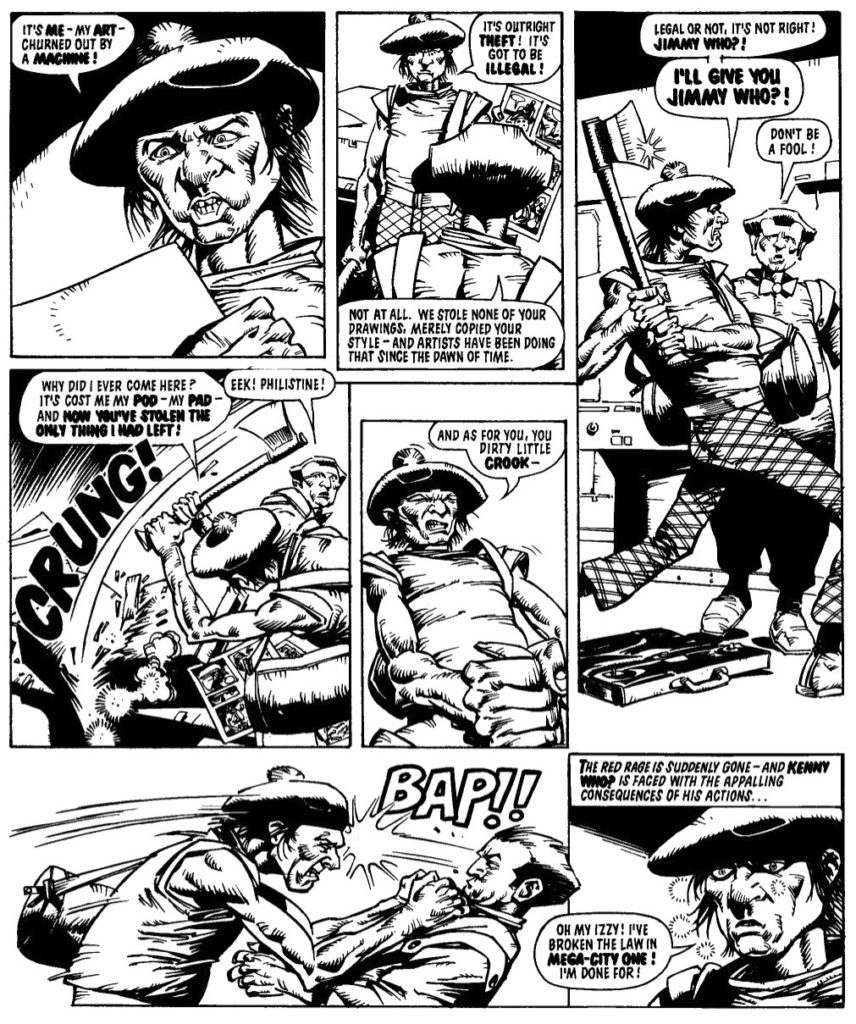
Going to the bar to drown his sorrows, he glimpses a television segment touting Big1’s new star artist – a certain ‘Jimmy Who?’ whose style he recognizes: “Big1 has stolen my talent!” he rushes to the company’s offices swinging an axe where the big boss takes him to see ‘Jimmy Who?’
It’s a computer – not even one of Mega City One’s humanoid robots, just a big box spawning pages, to which Kenny’s portfolio was fed as he waited to be interviewed the first time. When Kenny cries foul, which brings us back to the scene described in the opening of this article, the manager simply replies “We stole none of your drawings, merely copied your style – and artists had been doing that since the dawn of time.”
All of that – the feeding of art on a massive scale, the discounting of the human element, the shoddy treatment of the employee – is already there, decades before the technology became commonplace. As mentioned before, none of the creators had the gift of prophecy; nor is the story the result of some special technical know-how, most of the inventions featured in the pages of Judge Dredd remain as farcical today as they’ve been in the 1970’s. The Art of Kenny Who? is the story of the comics industry, which is also the story of America, which is also the story of capitalism.
In his 1935 essay “The Work of Art in the Age of Mechanical Reproduction” Philosopher Walter Benjamin sought to explore the way new technologies (mostly focused on new development in photography and cinema) would change the way art is produced, and how these changes would shape the culture. One of his stark observations was that humanity was first entering an era of mass reproducibility in the visual arts: “In principle a work of art has always been reproducible. Man-made artifacts could always be imitated by men. Replicas were made by pupils in practice of their craft[…] Mechanical reproduction of a work of art, however, represents something new.”
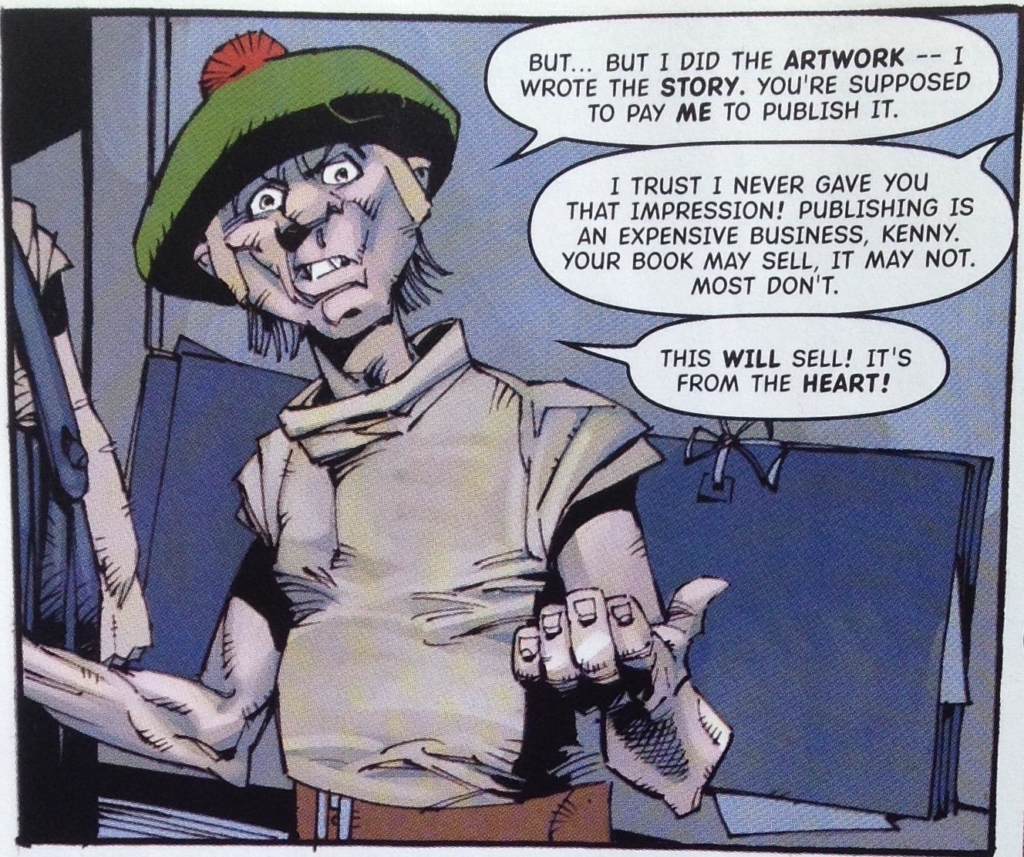
Previously, if you saw a work of art –a painting or a statue in a museum – you’d probably see the only possible version of that object. Each piece was unique, even attempts at exact replicas were probably different in many tiny ways, each had an ‘aura.’ No more, a movie can be copied over a dozen or thousand times with no version being more authentic than others. Our never ending struggle for finding the ‘authentic’ in art nowadays arises precisely from the problem of reproduction. The Mona Lisa is always the Mona Lisa, but which is the ‘authentic’ version of Star Wars? There have been so many editions, re-issues, updates and changes. Even calling the film Star Wars instead of Episode IV: A New Hope is a point of contention. As John Berger commented on Benjamin’s text: “For the first time ever, images of art have become ephemeral, ubiquitous, insubstantial, available, valueless, free[…]”
This sounds negative, and it certainly has the potential to be (Benjamin specifically tied mess art to the rise of Fascism), but it doesn’t have to be. Comics, as an entire medium, can only exist due to reproducibility. Art that can reach, and touch, millions, who no longer have to have a lot of spare time and money to go to the museum in a faraway city in order to see a painting. Reproducibility made Krazy Kat possible, it made Judge Dredd possible. More venues, more voices. Benjamin noted the transforming power of the printing press, which took the written word (part of the way) out of the hands of the rich and powerful: “With the increasing extension of the press, which kept placing new political, religious, scientific, professional, and local organs before the readers, an increasing number of readers became writers[.]” If we know how to use it right.
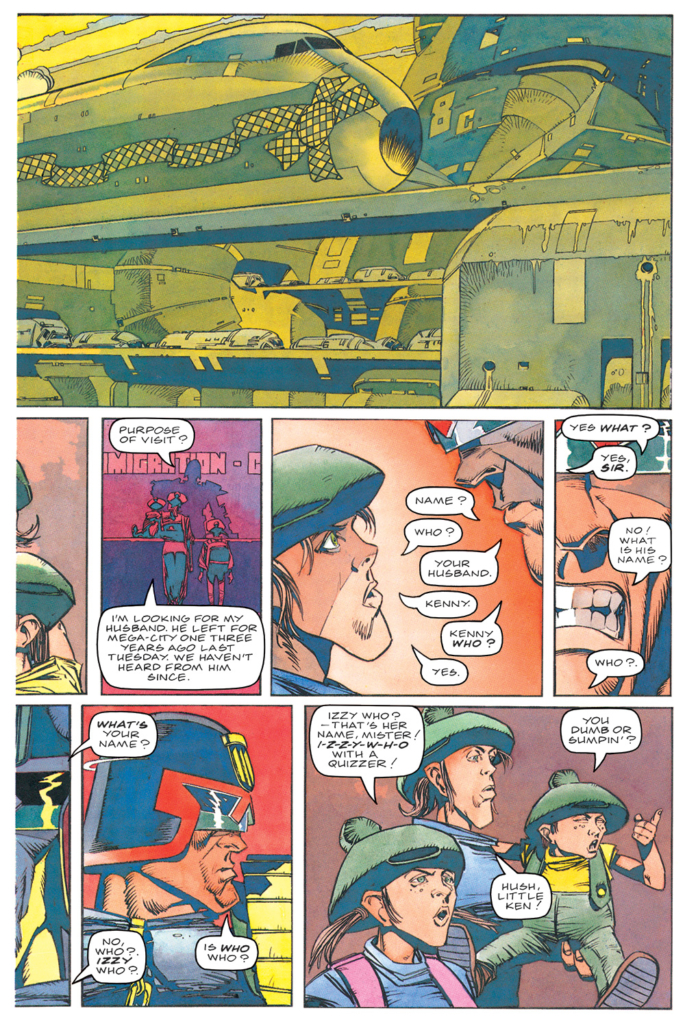
The second Kenny Who? storyline, Beyond our Kenny features Kenny’s family coming in order to beg for his release after being arrested by Judges for destroying his machine duplicate). Kenny’s wife visits the offices of Big1 and pleads with them, as the wounded party, to ask for leniency. She reminds the manager that Big1 had used Kenny’s art without his agreement, and that as the creator he has rights, at which point comes the most brutal moment of the comics happens and the senior editor opens the door to the office of the other creators (grey men standing next to a bunch of mechanical boxes) and shouts: “Hey guys! Get this – creators’ rights!” at which point the whole office erupts with laughter.
You can sense the bitterness emanating from the page. Wagner and Kennedy were both British creators (though Wagner was born in America he had spent the lion’s share of his life and work in the U.K) who were used to trying to get work in America. Kennedy testified that the character of Kenny was influenced by his own time in America: “In the 80s, I was sent to the States to pitch an idea to DC comic execs in New York. When I announced myself, a guy said, ‘Kenny who?’ It’s funny, but in a rather grim way. Here was a man who already made a name in his profession and he has to start all over again.
Though they both worked on several successful projects (with their Boba Fett series is probably as good as Star Wars comics got) they had to contend with the fact that it was all work for hire. The stuff that was creator owned, like Outcasts, hadn’t seen a reprint in ages, because then the corporate overlords would have to pay people more money.
The fact of the matter is, the comics industry didn’t need the invention of AI Art to find ways not to pay its creators. The industry, built from the ground up by gangsters, businessmen and businessmen-gangsters, was exploiting artists before computers existed. The very first published Judge Dredd strip, “Judge Whitey,” was drawn not by the character’s creator Carlos Ezquerra (he’d left 2000 AD before the first prog was published when he wasn’t offered enough). Instead, “Judge Whitey” was drawn by Mick McMahon specifically in Ezquerra’s style, much to Ezquerra’s anger. Many artists today can open up a social network and see someone casually training these newfangled engines by feeding their pages into it.
‘Art’ goes in, and ‘content’ comes out.
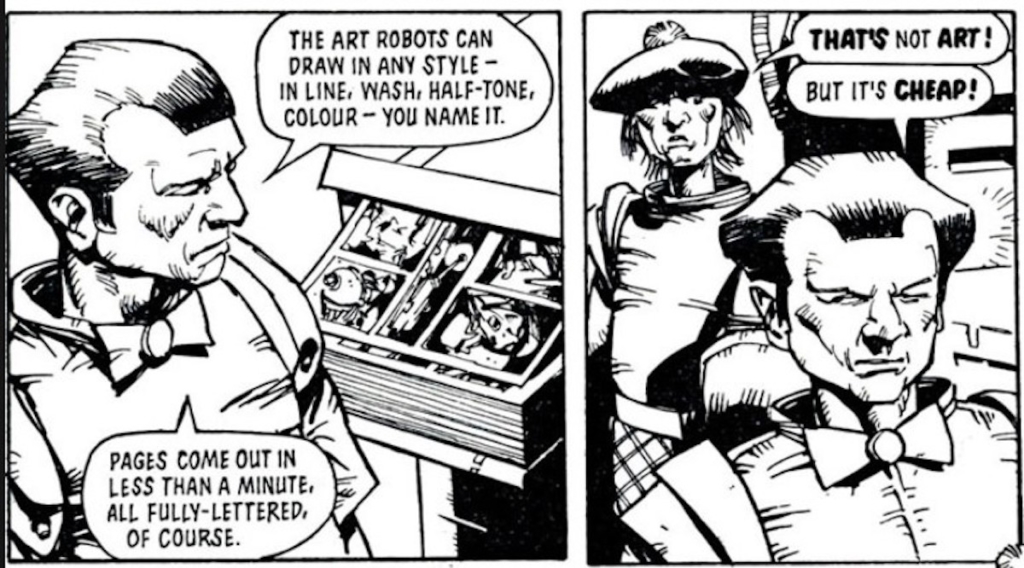
There’s a bitter irony to the fact that writers and artists of 2000 AD are recognized, to this day, as “script droids” and “art droids,” part of the magazine’s inner-mythology involving an alien editor coming to Earth to deliver comics unto the children of Great Britain. A fictional editor, in order to distract from the fact that real people were working on making that art without credit. This was the custom at the time in most British comics, several American comics were still operating without credit as well (if nothing else, one should give Stan Lee some credit for pushing his co-creators to the forefront of the readers’ attention). Kevin O’Neill’s daring decision to add credit boxes would’ve probably never gone through if he’d call it “writer” and “artist.” By keeping the credits as part of the fictional story, a story in which actual human beings are machines like ‘Jimmy Who?,’ O’Neill had managed to strike a huge blow for creators’ rights (no laughter please).
“We stole none of your drawings, merely copied your style,” says the senior editor, and that is true to a degree, at least. Trend-chasing has always been part of the comics industry, if a character or an artist became popular the people with the money would tell the people with the pencils to copy.
In the 1960’s everyone in Marvel was encouraged to draw like Jack Kirby, in the 1990’s people wanted to be Jim Lee, today’s young adult comics are often based on Raina Telgemeier. However, despite the clutches of the market there is still room in there for the human factor, for the development of a personal style. (Certainly, Mick McMahon didn’t remain an Ezquerra-clone for long.)
With AI Art, however, that is not the intention. People feeding ‘object X in the style of artist Y’ aren’t trying to synthesize something new, they are standing on the shoulders of giants and imagine it makes them giants as well. They trample on the shoulders of giants, asking the giants to stop making noise about it and brag they no longer need the giants. The senior editor at Big1 needed Kenny’s art, and once he got what he needed he threw the actual artist aside. I think of Marvel artist Herb Trimpe, who drew for the company ably for decades, and was cast aside once his style was no longer in vogue, just like shutting down a computer, his account of that period of unemployment is bleak.
Computer art can be a desolate avenue, but that is not because of the computer. That is because the people pushing the buttons.
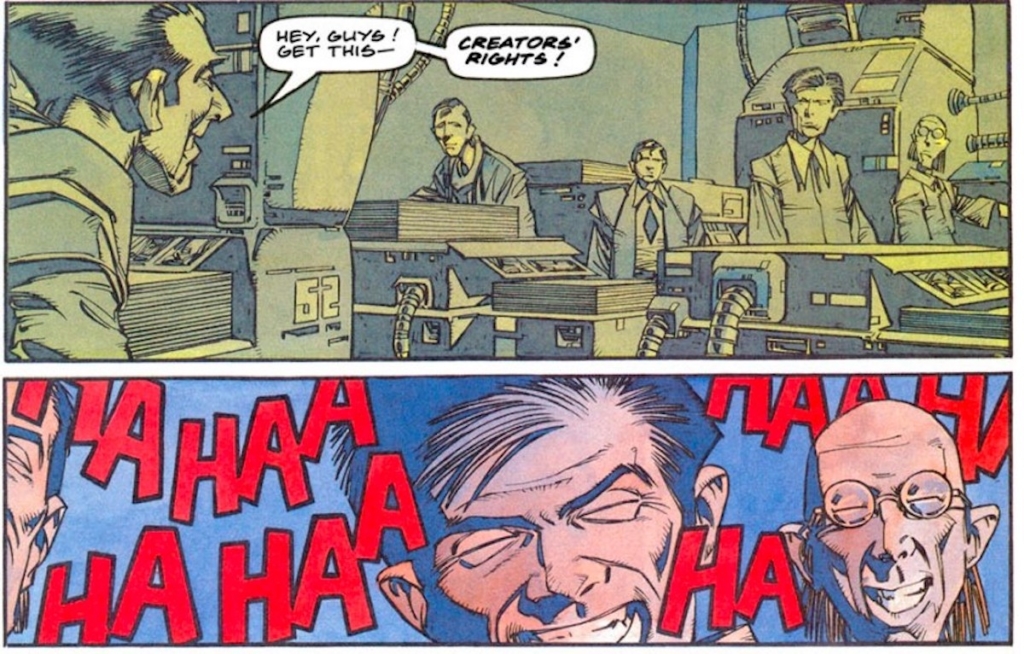
In Beyond our Kenny’s, Big1 makes a surprise about turn when they discover a competing comics made by a human artist is outselling all of their technically competent, but inherently soulless (or ‘aura less’ in Benjamin’s terms), work: “They never do the unexpected, the eccentric[…] they do not develop.” With no other human artist to turn to, having sucked dry all employment opportunities for living artists, they turn in panic to the imprisoned Kenny.
But things go wrong, as they often do, and Kenny finds himself banished from Mega City One. As the years pass we reach the final story of the saga Who? Dares Wins which sees Kenny returning to America to another swing at being published – only to learn that the ‘human thing’ was just a short fashion. Robots are back in force, even replacing the human managers. No one comments on that fact, but the person who stole Kenny’s art in the first place appears to have his work likewise stolen. If capitalism does not contain the seeds of its own destruction, it certainly contains the seeds of destruction for those who play the game with abandon.
The machine, not the fictional robots of Mega City One but the machine of capital, does not care for people. Those who adopt the tenants of the machine, who act gleefully when artists lose their chance of employment in an industry and a country that already treats employees like replaceable cogs, will find themselves replaced as well. Kenny ‘wins’ by self-publishing. It might not make him rich but it affirms what he always knew himself to be – an artist.
Prog 2305 of 2000 AD opens with a letter from the fictional editor, Tharg the Mighty, master of these art droids, who promises “you’d think I’d be all for A.I.s taking control – but no. I make the decisions here, and organic matter is still very much in charge!” At least we know these people read, and understand, their own stories.
It’s not perfect, sometimes it’s downright ugly, but it’s art.
